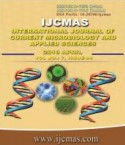


 National Academy of Agricultural Sciences (NAAS)
National Academy of Agricultural Sciences (NAAS)

|
PRINT ISSN : 2319-7692
Online ISSN : 2319-7706 Issues : 12 per year Publisher : Excellent Publishers Email : editorijcmas@gmail.com / submit@ijcmas.com Editor-in-chief: Dr.M.Prakash Index Copernicus ICV 2018: 95.39 NAAS RATING 2020: 5.38 |
An experiment was conducted involving 10 diverse parents and their 24 hybrids obtained by line x tester mating design laid out in randomized block design with three replications. The analysis of variance revealed presence of ample variability for fifteen quantitative traits studied. The genotypes Katargam, GP-167, GP-158 and GP-kh-64 were found to be good general combiners for one or more yield attributes. The cross combination GP-167 x Katargam exhibited highest mean values and standard heterosis over check variety Gujarat Papadi-1 for green pod yield per plant followed by GP-167 x GNIB-21 and GP-189 x GNIB-21. These hybrids had good general combining parents, high sca effects and heterotic effects over better parent as well as standard check. Both additive and non-additive gene actions played important role for the inheritance of most of the traits. While, only non-additive gene action was responsible for days to flowering, plant height, primary branches per plant, seeds per pod and straw yield per plant. The ratio of σ2gca / σ2sca indicated the preponderance of non-additive gene action for all the traits except green pod yield per plant. The superior hybrids may be advanced to obtain transgressive segregants and purelines for higher green pod yield per plant. As the development of hybrid variety is not possible in Indian bean, diallel selective mating system may be adopted for improvement of remaining traits followed by some sort of biparental mating and recurrent selection.
 |
 |
 |
 |
 |